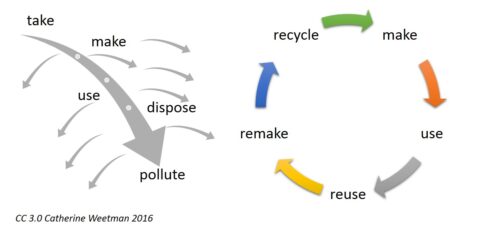Writer: Tamara Kristensen
The beauty and personal care industry is, for the most part, not sustainable. This is a fact. Like the fashion industry, underneath the glamour and beauty, is a whole lot of pollution. Specifically in the beauty and personal care industry, microplastics are a huge issue. These are extremely tiny beads found in personal care products such as exfoliating gels, scrubs, shampoo and so on. That reaaally nice exfoliating scrub you use when you want to treat yourself? Not so nice for the fish, unfortunately. Because when we use them, they go down the drain and can’t be recycled, nor can they decompose in wastewater sewage systems.
This is why Conscious Living encourages conscious living, and here’s how the company’s economic approach is geared towards this.
What is a circular economy?
This figure explains a linear economy (the general economic structure at the moment), and a circular economy. A linear economy is simple: make, use, dispose. Conscious Living strives to adopt a circular economy business model, so we aim to produce no net waste. This includes how we use our resources, and how efficiently. Here are a couple things Conscious Living has done in order to take the steps towards a circular economy.

This image shows a diagram of a linear vs. circular economy approach.
1: Make.
Our agricultural practices when extracting ingredients are framed by a strategy beneficial for both the villagers and the environment. There is no machinery involved in the extraction process and everything is produced naturally. No waste is created in the manufacturing of the products. Furthermore, our agricultural practices are localised; it is done with and in support of the community.
2. Use.
This is where waste is unfortunately created. This primarily comes from shipping, both to customers directly and to retail stores. However, we make a conscious effort to not use express shipping, as this creates more of a carbon footprint. Furthermore, the same containers are used to ship the products in order to reduce container wastage.
3. Reuse.
We encourage our customers to make use of our refill stations, rather than buy an entirely new bottle for each product. Furthermore, customers are also encouraged to dilute their products (such as soap) so it last longer and reduce the need to refill or repurchase more often.
4. Remake.
If you prefer not to refill your bottles at the refill stations, you can also take part in our #rescuethebottle project. While our refill stations have reduced our retail sales of packaged bottles, customers may still prefer the convenience of repurchasing packaged bottles. In this case, you can easily send back or drop off your bottle back to us to be cleaned, sanitized and essentially remade into a brand new packaged bottle!
5. Recycle
We have a running cycle with nature. We rely on nature for our ingredients, so in exchange, we make sure nature can rely on us. The lack of harsh chemicals in our products ensures that when our products enter the drainage system, they do not cause environmental degradation as many other personal care products do. For instance, see the harsh chemicals we avoid in our shampoos.
With these practices in place, Conscious Living is constantly looking to innovate and take steps towards becoming a model for sustainable businesses. It is becoming exponentially more important for economies and businesses to include sustainability in their policy goals and adopt a circular model for the economy.
However, we also need the support of our consumers in this endeavour. Take part in our initiatives towards being kinder to the environment! You can learn more about us on our ‘About Us‘ page, get in touch with us for more information, or shop from our range of products.



